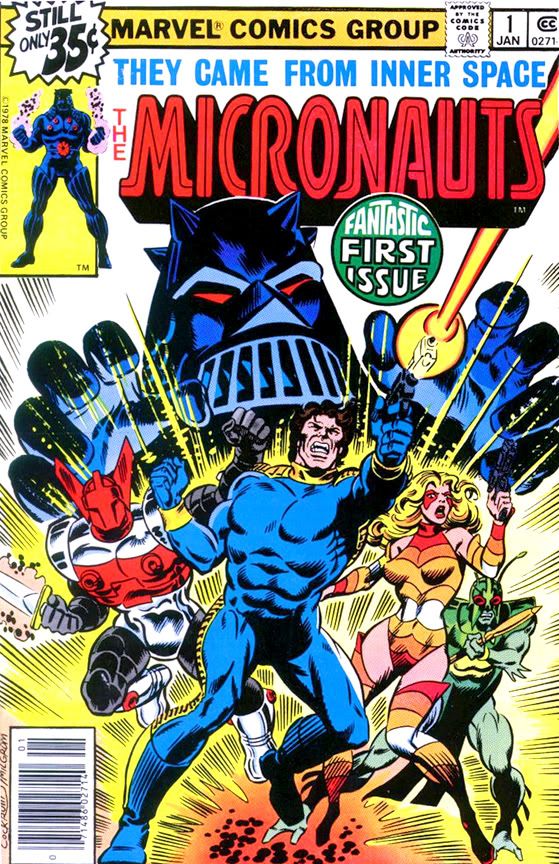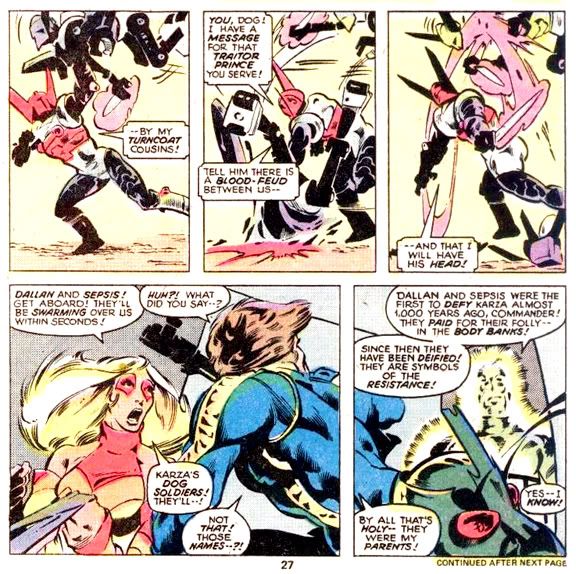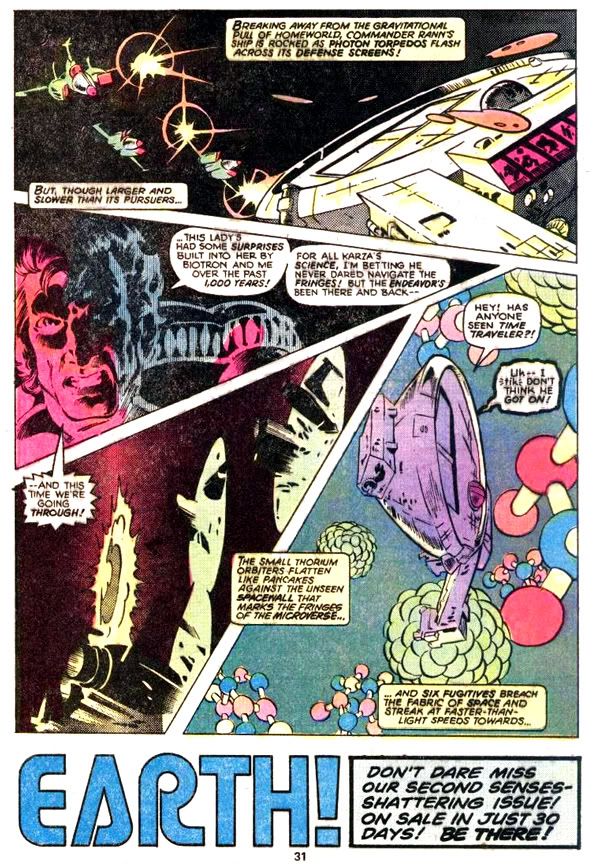 Summer is upon us and that means school's out, big-budget/small-brained blockbusters dominate the nation's movie screens, there's nothing on TV but reality shows and dramas too lame to make the regular season and people are putting down their hefty copies of James Joyce's Ulysses and picking up lighter reading fare. My suggestion?
Summer is upon us and that means school's out, big-budget/small-brained blockbusters dominate the nation's movie screens, there's nothing on TV but reality shows and dramas too lame to make the regular season and people are putting down their hefty copies of James Joyce's Ulysses and picking up lighter reading fare. My suggestion?Marvel's Micronauts series. It's kind of like the Star Wars comic that never was, only there was a Star Wars comic that was also kind of like Micronauts. Actually, the first Star Wars artist Howard Chaykin later illustrated a few issues of Micronauts, which is a neat overlapping of similar summer fun fare. While Bill Mantlo filled the Arthur Digby Sellers role and wrote the bulk of the series (all 59 issues of the first volume), superstar artist Michael Golden illustrated the first 12 issues and its classic storyline, a dimension-spanning epic featuring a hero with a connection to a mysterious cosmic force, a couple of plucky robots, a spunky space princess and their rebellion against a black-armored mastermind and his Nazi-like army. Which reminds me of something or other. Battlestar Galactica?
In the first issue, Commander Rann, a bold explorer, returns to his home planet after centuries in deep space only to find himself something of a legend and his parents-- the former king and queen-- worshiped as gods. And their science adviser Baron Karza ruling the place with an iron fist. Sensing a threat to his regime, Karza has Rann imprisoned. This proves to be a mistake, because it isn't long before Rann makes friends with the stoic warrior Acroyear, his comedic relief insectoid buddy Bug and Princess Mari, sister of the deposed Prince Argon. Together, they become a team of freedom fighters. But first they have to escape Karza's dungeons.
Mantlo quickly sketches his world and its central conflict, filling his story with action sequences and little snippets of characterization. Princess Mari is so spirited she has to be convinced by her self-sacrificing brother to flee and fight another day, Rann conquers his initial confusion and takes charge of his own destiny, Bug cracks jokes and Acroyear provides muscle. And it's all gloriously illustrated by Golden and inker Josef Rubenstein. Taking as his inspiration a line of Japanese toys imported by the Mego company, Mantlo grafts on a few elements of Flash Gordon, the first Star Wars movie (there wasn't a second in those days) and Jack Kirby's Fourth World. Golden has always excelled at this kind of material-- armored warriors, sci-fi weaponry ever so slightly exaggerated from real-world examples, starships and fire-fights.
 Hot Acroyear-on-Acroyear action! Notice how Golden makes the character Acroyear look "real," but the anonymous enemy version looks like one of the Mego toys, complete with metal joints!
Hot Acroyear-on-Acroyear action! Notice how Golden makes the character Acroyear look "real," but the anonymous enemy version looks like one of the Mego toys, complete with metal joints!Mantlo's script really turns him loose. I remember looking at issue #2 and being completely enthralled with Golden's artwork. The way he seemed to draw every nut and bolt on the robots and the starships, the lighting effects that reminded me so much of the movies-- rather than the fairly flat figures I'd been used to from coloring books and Super Friends cartoons.
And, of course, the Micronauts end up on earth, where they're exactly the same size as the action figures my friends and I were so crazy about that year. Yeah, my best friend owned practically every Micronauts toy, no matter how complex or expensive. He never particularly cared for the comic book, but I was hooked, at least initially. The only problem was, it was so difficult to find. I never saw #1, didn't find another issue until #4 (introducing my favorite 'Naut, the valiant guerrilla leader Slug), managed to get #5 (the Micronauts invade NASA) and #6 (they fight Man-Thing in a swamp) and then nothing until #12 (the post-climactic battle between estranged brothers Acroyear and Shaitan, a traitor). And yet thanks to Mantlo's ability briefly recapitulate the action from previous issues, I never felt lost or left behind.
If the series had ended there, it would've been the first maxi-series, I suppose. Or a pioneering graphic novel. But it was popular and financially lucrative enough to continue. So Golden handed off the interior art chores to Chaykin-- something I didn't discover for months. I honestly thought the story was over. Imagine my surprise when I found Micronauts #17 (guest-starring the Fantastic Four) and #18 at a convenience store in Florida. Same awesome Golden covers, but with Chaykin story art inked by Al Milgrom that, frankly, left me appalled. Later I came to appreciate and admire Chaykin when he inked himself, but I dropped the title in dismay for a while. It wasn't until I came across #20 with pencils by Pat Broderick and inks by Armando Gil that I became a re-confirmed Micronauts fan and stuck with the book through all the repetitive Karza returns-- how many times can this guy take over Argon's mind and re-conquer over the Microverse?-- and laborious trips back and forth through time and space, Nick Fury and Timothy Aloysius Cadwallader "Dum Dum" Dugan and the X-Men showing up, visits to increasingly familiar locales like the same NASA laboratory they'd already escaped from. Gil Kane provided some memorable covers but had his distinctive look on the pages inside all but obliterated by some heavy-handed Dan Bulanadi inks; hey, I just told you I like Pat Broderick's stuff, but I don't think Gil Kane's art needs to look anything like it. There were still plenty of fun moments, but Mantlo really seemed to be writing stories in circles. Maybe that's what Marvel wanted-- those amazing first twelve issues repeated endlessly.
Well, that's hindsight. At the time, that's what I wanted too! That and more Slug.
I recently found #3 and #4 in practically mint condition at my local comic book shop, and re-reading those I can feel those summer breezes and see the cool morning grass still wet with dew. It's like being 10 years old again, only now I no longer have my lush, androgynous 70s hair and I fart more frequently. If you can find the first 12, you really need to buy them and read them this summer. They're a lot better than that John Grisham book with the wrinkled spine and the cookie crumbs flattened against some of the pages you're going to find in the magazine basket in your beach condo and probably no more expensive than that braindead 3D robot movie that's going to leave your ears ringing and your head pounding from lost IQ points.



No comments:
Post a Comment